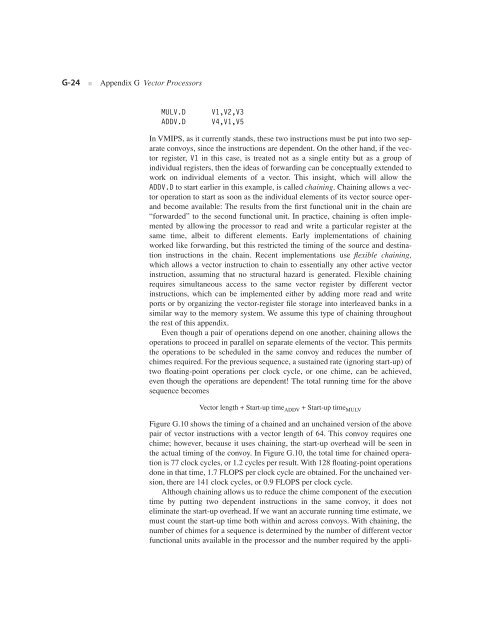Appendix G - Clemson University
Appendix G - Clemson University
Appendix G - Clemson University
Create successful ePaper yourself
Turn your PDF publications into a flip-book with our unique Google optimized e-Paper software.
G-24 ■ <strong>Appendix</strong> G Vector Processors<br />
MULV.D V1,V2,V3<br />
ADDV.D V4,V1,V5<br />
In VMIPS, as it currently stands, these two instructions must be put into two separate<br />
convoys, since the instructions are dependent. On the other hand, if the vector<br />
register, V1 in this case, is treated not as a single entity but as a group of<br />
individual registers, then the ideas of forwarding can be conceptually extended to<br />
work on individual elements of a vector. This insight, which will allow the<br />
ADDV.D to start earlier in this example, is called chaining. Chaining allows a vector<br />
operation to start as soon as the individual elements of its vector source operand<br />
become available: The results from the first functional unit in the chain are<br />
“forwarded” to the second functional unit. In practice, chaining is often implemented<br />
by allowing the processor to read and write a particular register at the<br />
same time, albeit to different elements. Early implementations of chaining<br />
worked like forwarding, but this restricted the timing of the source and destination<br />
instructions in the chain. Recent implementations use flexible chaining,<br />
which allows a vector instruction to chain to essentially any other active vector<br />
instruction, assuming that no structural hazard is generated. Flexible chaining<br />
requires simultaneous access to the same vector register by different vector<br />
instructions, which can be implemented either by adding more read and write<br />
ports or by organizing the vector-register file storage into interleaved banks in a<br />
similar way to the memory system. We assume this type of chaining throughout<br />
the rest of this appendix.<br />
Even though a pair of operations depend on one another, chaining allows the<br />
operations to proceed in parallel on separate elements of the vector. This permits<br />
the operations to be scheduled in the same convoy and reduces the number of<br />
chimes required. For the previous sequence, a sustained rate (ignoring start-up) of<br />
two floating-point operations per clock cycle, or one chime, can be achieved,<br />
even though the operations are dependent! The total running time for the above<br />
sequence becomes<br />
Vector length + Start-up time ADDV + Start-up time MULV<br />
Figure G.10 shows the timing of a chained and an unchained version of the above<br />
pair of vector instructions with a vector length of 64. This convoy requires one<br />
chime; however, because it uses chaining, the start-up overhead will be seen in<br />
the actual timing of the convoy. In Figure G.10, the total time for chained operation<br />
is 77 clock cycles, or 1.2 cycles per result. With 128 floating-point operations<br />
done in that time, 1.7 FLOPS per clock cycle are obtained. For the unchained version,<br />
there are 141 clock cycles, or 0.9 FLOPS per clock cycle.<br />
Although chaining allows us to reduce the chime component of the execution<br />
time by putting two dependent instructions in the same convoy, it does not<br />
eliminate the start-up overhead. If we want an accurate running time estimate, we<br />
must count the start-up time both within and across convoys. With chaining, the<br />
number of chimes for a sequence is determined by the number of different vector<br />
functional units available in the processor and the number required by the appli-

















